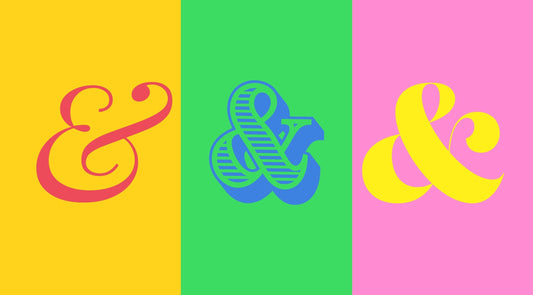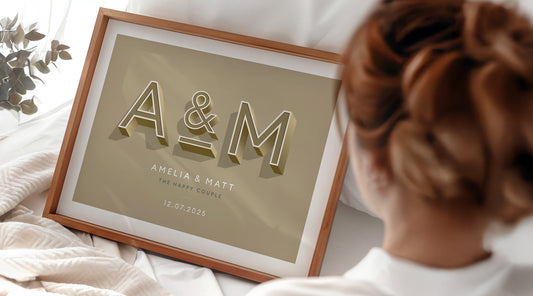The ampersand is a classy, refined, well-rounded, perfectly proportioned character that in my opinion, is far more than just a shortcut for ‘and.’ And I have to say, for so many reasons – I love it!
More than a stylish flourish, it's a symbol that has been with us far longer than the English language has. From high-quality greetings cards to upscale logos, you will see its shape most everywhere. But to understand the seemingly timeless appeal of this graceful piece of punctuation, we need to have a look at the ampersand origins story.
Ampersand Origins and Historical Meaning
The origins of the ampersand go back to ancient Rome, where it was originally formed as a short form variant of the letters ‘e’ and ‘t‘, spelling the Latin word ‘et’, meaning ‘and’. Over time, scribes stylised and formalised the symbol into the arcing and flowing punctuation that we know today, becoming the & shape we know and love in around the 1800s.


The name ‘ampersand’ has its own slightly quirky history. The name comes from the mixed English and Latin phrase: “and per se and” which literally means “and by itself is and”, with the first and referring to the & symbol. Confusing and redundant or not, it does mean the symbol does almost literally what it says on the tin - or rather in its name.
The ampersand still divides the crowd! Many love it for being economical to write, or a space-saving substitute for ‘And’ (such as online writers who face strict character count restraints), while others feel it negatively impacts on legibility and comprehension, so would rather it was sidelined. The curvy creation was once considered the 27th letter of the alphabet, recited after A-Z, and in my view still deserves its place in the alphabet as we know it today.
Ampersands In Branding
The Ampersand has always been a popular device in logo and identity design featuring across some of the world's most popular clothing, fashion, culture, food, healthcare and business brands.
Often clearer visually than the word ‘and’ especially from a distance or a quick glance, the ampersand is a sensible choice for logos and branding, however it’s not just used for clarity. Being steeped in Latin tradition, as well as being widely adopted among the academics in England throughout the centuries, the ampersand very much carries a timeless, but somewhat elite air.
As such, the ‘&’ adds a touch of elegance to any branding, and is beloved by partnerships and collaborations, forming many new brand names after mergers and acquisitions.
From iconic cultural institutions like the V&A; global fashion giants such as Dolce & Gabbana and H&M; prestige retailers like Selfridges & Co and Tiffany & Co and household family favourites like M & Ms - the ampersand is a unique identifying feature that carries a lot of weight for a small character.
 Logo examples: V&A, Bloom & Blossom, Bang & Olufsen, Ben & Jerry’s, Tiffany & Co, H&M, Selfridges & Co and M&S.
Logo examples: V&A, Bloom & Blossom, Bang & Olufsen, Ben & Jerry’s, Tiffany & Co, H&M, Selfridges & Co and M&S.
But it somehow is able to do far more than that. Used in the right way it conveys traditional values of authority, trust and reliability – at the same time as embedding a sense of warmth, authenticity and belief that would otherwise be missing from a partnership brand. Think Johnson & Johnson, Barnes & Noble, Ben & Jerry’s and the likes of Waitrose & Partners to name a few.
And with its boundless versatility, the Ampersand, more than any other letter, has given type and logo designers licence to create highly decorative, fun, iconic and even flamboyant characters, helping elevate branding solutions to a whole new level.
In my view this point is best illustrated by two logo examples: The iconic V&A logo, designed by Alan Fletcher and Pentagram in 1989, which creates a visual bridge between the ‘V’ and ‘A’ using a Bodoni-inspired ‘&’; and the more recent 'Bloom & Blossom’ logo created by Alec Tear which seamlessly integrates the ‘&’ within the reflected words.

If that weren't enough, the ampersand makes excellent practical sense. It's economical and efficient in its use of space, offers a high degree of clarity as a single character, and by avoiding the need for the word 'and’ to be spelt out, also overcomes the need for translation across international markets.
A Personal Love of the Ampersand
I have always had a personal fascination with the ampersand, so when Karen and I were considering what to call our small creative business, finding a name that incorporated an ‘&’ was a big priority!
After endless rounds of brainstorming, we finally arrived at a name that reflects my long-standing love of typography and lettering (think alph-a-bet) along with the idea of two individuals (Alf and Bet) coming together as a creative husband and wife partnership. And with that, Alf & Bet was born.

And while we couldn't be considered famous (yet), we do share a common love of the ampersand with some of the world's best known brands – and I'm chuffed this stylish symbol has taken pride of place at the heart of our logo design.
A Truly Versatile Character
Whether it is used to save space in a design, to make sure that the unity of a brand partnership is immediately clear, or to utilise the combination of centuries old use in all forms of literature and art, the ampersand is far more than a simple punctuation mark.
As much as the ampersand has a function and works beautifully when arranged with other letters, to me, it’s just as good on its own - and I know that I’m not the only one who holds the ampersand with such high affection!
To that end, I’ve put together some of my favourite examples from historic and classic typefaces, through to more recent contemporary fonts. Take a moment to admire the grace and enduring appeal of the ampersand, and I’ll let you judge for yourself which of them you think is the best.



Ampersand Type Prints
If you love the Ampersand, you can find it on some of our personalised prints and on our golden ampersand greeting card, perfect for celebrating romantic unions between two people like engagements or weddings, or for celebrating the addition of a new baby to the family. Here are some examples to inspire you!


See our Personalised Letter Prints






